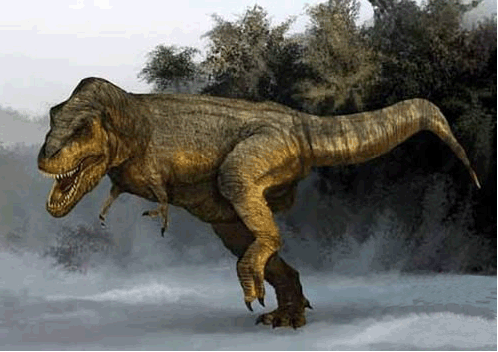The teeth that were found near the T-Rex had been shed.
这些牙齿在霸王龙化石附近被发现。
But were the teeth broken during a battle, or could the Nanotyrannus have simply found the dead T-Rex and lost them scavenging on his remains?
但是它们是在战斗中脱落的,还是矮暴龙找到了霸王龙尸体进食的时候掉下了的呢?
The prehistoric scene again provides some clues.
史前的场景再次提供了一些线索。
It is estimated that between 75 and maybe 90% of the baby Tyrannosaurus Rex was found.
据估计人们找到了幼年霸王龙百分之七十五到九十的身体。
If Nanotyrannus had been scavenging it for food, then we would expect that the majority of the bones would have been gone,
如果矮暴龙是找到并进食其尸体这种情况下,大部分骨头都会不见,

or at least the skeleton would been torn up and disarticulated.
最起码骨架应该被撕开并且变形。
But the fact that so much of the skeleton remained,
不过因为骨架的大部分都完好,
and the pieces were found in relative proximity to each other tells me that Nanotyrannus was biting the baby T-Rex, but not eating it.
而且找到的骨头相互位置相对合适,这说明矮暴龙咬了幼霸王龙但是并没有吃它。
But why would a Nanotyrannus risk its life to attack a juvenile T-Rex but not eat it?
不过为什么矮暴龙会冒生命危险去攻击幼霸王龙却又不吃它呢?
Competition between predators has existed from the beginning of time.
掠食者间的竞争从一开始就已经存在。
Being able to out-compete your opponent is a way to insure your survival.
能够在竞争中胜出对手是保证生存之道。
Being faster, smarter or stronger gives you a competitive edge,
更快速、更聪明或更强壮能让动物具有竞争优势,
but in the case of Nanotyrannus, he could never compete with an adult Tyrannosaurus Rex.
不过对于矮暴龙来说,它绝不会跟成年雷克斯暴龙竞争。
It has no chance of killing an adult, so killing a baby is what it needed to do to survive.
要杀死成年霸王龙,它绝无机会,所以它为了生存需要杀死幼霸王龙。
But why it didn't eat it remains a mystery.
不过为什么它没有吃掉尸体是个谜。
Perhaps it was buried very quickly after death and the Nano just didn't have time to eat it,
也许是因为尸体在死后很快被埋上了,矮暴龙没有时间吃掉它,
or maybe something interrupted him before he could take advantage of that potential meal.
也许是有什么事情打断了它因而没来得及享用这顿美餐。



